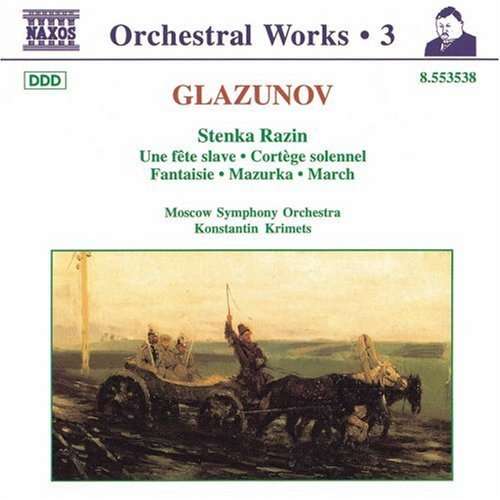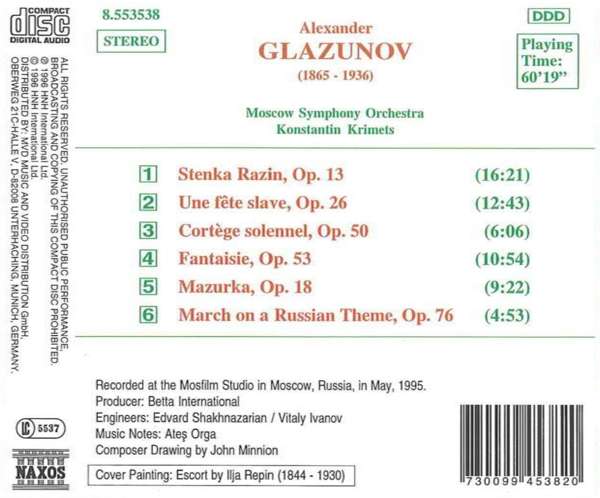
classical music distribution


(Produkt nie został jeszcze oceniony)
kompozytor
Glazunov, Alexander
tytuł
GLAZUNOV: Stenka Razin
wykonawcy
Moscow Symphony Orchestra;
Krimets, Konstantin
Krimets, Konstantin
nr katalogowy
8.553538
opis
The rhythmically vibrant symphonic sketch Une fete slave (Slav Holiday), Op. 26a (1888), was an adaptation of the orchestrally suggestive Ukrainian dance-finale from the popular G major String Quartet, Op. 26. Written in the wake of Tchaikovsky's suicide the previous November, the (first) Cortege solennel in D major, Op. 50, and the Fantaisie, Op. 53, both date from 1894. Glazunov subtitled the latter From darkness to light, musically representing such transfiguration by beginning in pathetique B minor and closing in "white" C major - a familiar enough old Neapolitan relationship (think of Haydn and Beethoven) but also a very Russian one in its semitonal sidestepping. •
According to his pupil Shostakovich, Glazunov "insisted that composing ballets [and by extension dance music] was beneficial because it developed your technique... he was right". The Mazurka in G, Op. 18 (1888), was the first of several "concert" dances for orchestra independent of a balletic / cyclic context. Together with the earlier Wedding Procession (March), Op. 21 and Triumphal March, Op. 40, the March on a Russian Theme, Op. 76 (1901) shares the same militaristically heroic key of E flat perorated by Mussorgsky in the "Great Gate of Kiev" and Tchaikovsky in his 1812 Overture.
nośnik
CD
gatunek
Muzyka klasyczna
producent
Naxos
data wydania
09-09-1996
EAN / kod kreskowy
730099453820

(Produkt nie został jeszcze oceniony)
cena 58,00 zł
lubProdukt dostepny w niewielkiej ilości.
Wysyłka w ciągu 3 dni roboczych
Darmowa wysyłka dla zamówień powyżej 300 zł!
Darmowy kurier dla zamówień powyżej 500 zł!
sprawdź koszty wysyłkiProduktu jeszcze nie zrecenzowano, chcesz być pierwszy?
Klienci, którzy kupili ten produkt, kupili również
różni kompozytorzy
Te Deum Laudamus: Music on the Angel Instruments from 1594 in Freiberg Cathedral
CPO 777 928-2
Tchaikovsky, Piotr, Saint-Saëns, Camille, Rossini, Gioachino
New Year's Eve in St.Petersburg
BAC 030
Pozostałe płyty tego kompozytora
Tchaikovsky, Piotr, Glazunov, Alexander, Titz, Anton Ferdinand
Russian Treasures – Quartets
SM 241
różni kompozytorzy
Glazunov: Violin Concerto + Tchaikovsky, Chausson, Sarasate, Saint-Säens
NI 6316
Glazunov, Alexander
GLAZUNOV: Orchestral Works, Vol. 9 - Finnish Fantasy, Finnish Sketches, Karelian Legend
8.553839
Pozostałe płyty tego wykonawcy
Malipiero, Gian Francesco
Malipiero: Symphony No. 7, Sinfonia in un tempo, Sinfonia per Antigenida
8.570881
Malipiero, Gian Francesco
Malipiero: Symphonies Nos. 1 & 2, Sinfonie del silenzio e della morte
8.570879
Napisz recenzję dla: GLAZUNOV: Stenka Razin
Zapytaj o dostępność produktu
Twoje zapytanie:
Odpowiemy na adres:
Produkt został dodany do koszyka

Glazunov, Alexander
GLAZUNOV: Stenka Razin
1 szt












































